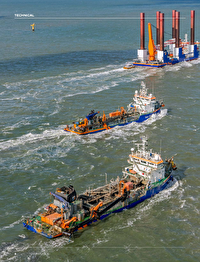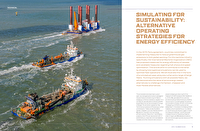This article demonstrates how to use an open-source logistical simulation package for the optimisation and planning of a fleet of dredging or offshore installation vessels. For a conceptual use case, we simulate all possible barge fleets that can be composed of a range of barges. Per simulation, we extract Key Performance Indicators (KPIs) along a number of dimensions. These include the classic fastest, cheapest, and most flexible scenario. We extend it here with the most energyefficient scenario. Note that in real dredging projects, other KPIs can also be dominant: in some harbours, noise restriction windows are imposed, and often there are restrictions to prevent dredging plumes or spill of fine material from settling basins (Van Eekelen et al., 2015). We use these KPIs to rank the simulations along these dimensions, allowing the contractor to properly weigh the options and consider an energy-efficient compromise. The weighing of different scenarios has always been in the scope of a dredging project. However, the anticipated focus in our sector on fuel efficiency serves as a trigger to revisit this classical challenge. Fuel efficiency will increase the solution space by at least an order of magnitude. We believe simulations can contribute to getting most value out of the extra options.
For the simulations, we use the OpenCLSim package introduced by De Boer et al. (2022) and Baart et al. (2022). In their work, they showed its applicability for the dredging sector with the example of one dredging cycle and a number of coupled dredging cycles with one cutter and a number of barges. In this article, we extend their case by running a range of simulations for the coupled dredging cycles. Further, OpenCLSim was lacking two features that were needed in the context of energy reduction. In this article, we add a critical path analyser to OpenCLSim to consider to what extent barges are on the critical path. Secondly, we add a routing component for sailing to take the fleet mobilisation phase into consideration.
After running all scenarios and choosing an energy-efficient compromise, we export a handful of scenarios to general purpose, industry-standard planning and Business Intelligence (BI) tools. This enables a range of stakeholders to analyse the optimal scenarios and assess it in the context of the available options. We believe these tools will democratise the traditional planning process beyond experts. Adding an energy-efficient scenario alongside the cheapest and fastest scenarios may result in a compromise scenario that has the best overall score but does not necessarily have the best score in terms of cost, time or fuel efficiency alone. The most energy-efficient scenario may entail additional costs, fuel saving options or delays that will have to be borne by one of the parties involved. Simple data analysis tools will allow each stakeholder to understand and compare the concessions required from them to accept the energy-efficient compromise scenario, rather than just the cheapest, fastest or most energy-efficient scenario. We foresee that BI tools will support conversations and facilitate reaching a mutual agreement among the contractor, client, NGOs, financing bodies and other stakeholders.
We shall first explain the use case central in this article: a range of scenarios for a fleet of one cutter and a number of barges. Next, we provide a recap of the core of OpenCLSim as described by De Boer et al. (2022). We explain how we added the critical path analyser. We added a routing component for ships to sail over a network with known physical dimensions (depth, width). This allows us to compute the power profiles needed for detailed fuel and emission estimates. We proceed with the method to compare and weigh the alternatives and choose an menergy-efficient compromise. Finally, we explain how planning and BI tools can lead to better analysis of the chosen scenario.
























